SafeHome.org may receive compensation from some providers listed on this page. Learn More
We may receive compensation from some providers listed on this page. Learn More
SafeHome.org may receive compensation from some providers listed on this page. Learn More
We may receive compensation from some providers listed on this page. Learn More
We tested over $1,200 worth of Frontpoint equipment and found a decent DIY home security system with local video storage and wide smart home compatibility.
Frontpoint offers a nice middle ground between full-service home security companies like Vivint and ADT, and DIY companies like SimpliSafe and abode. While Frontpoint requires a monitoring subscription, installation is entirely DIY and they work hard to keep prices affordable.
Over the past year, Frontpoint has reduced their equipment prices and restructured their monitoring plans completely. These are why it continues to rank among our best home security systems. Like SimpliSafe, they offer more flexible monitoring options, including a $15 monthly self-monitoring plan.
We purchased, installed, and thoroughly tested a Frontpoint security system. Here’s our hands-on experience to help you decide if Frontpoint matches your security needs.
Check out more recommendations from the SafeHome team:
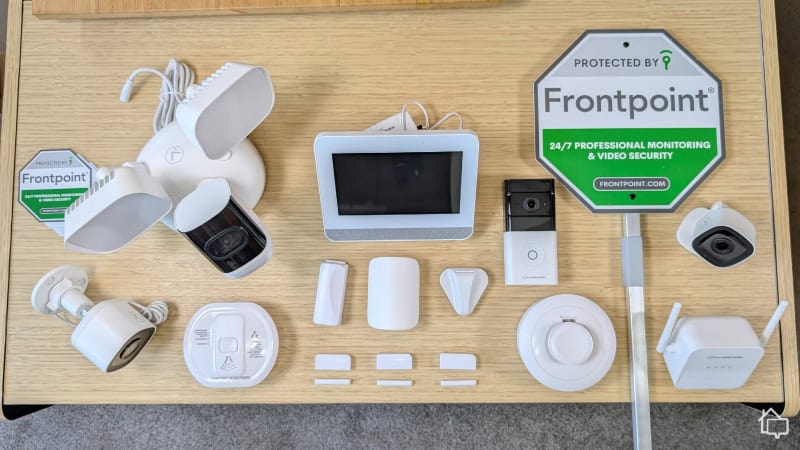
Our $1,200+ Frontpoint equipment laid out on a desk.
You can purchase Frontpoint equipment through their website or by calling their sales team. We prefer the online shopping experience. Frontpoint’s website is intuitive and provides detailed descriptions for each device. The transparent pricing also helps avoid potential upselling tactics that sometimes happen during phone orders.
Monitoring plans have a dedicated page, but only one option is available for purchase online. You’ll have to speak to the sales team if you want to subscribe to the others.
>> Learn More: The Best No-Contract Home Security Systems of 2025

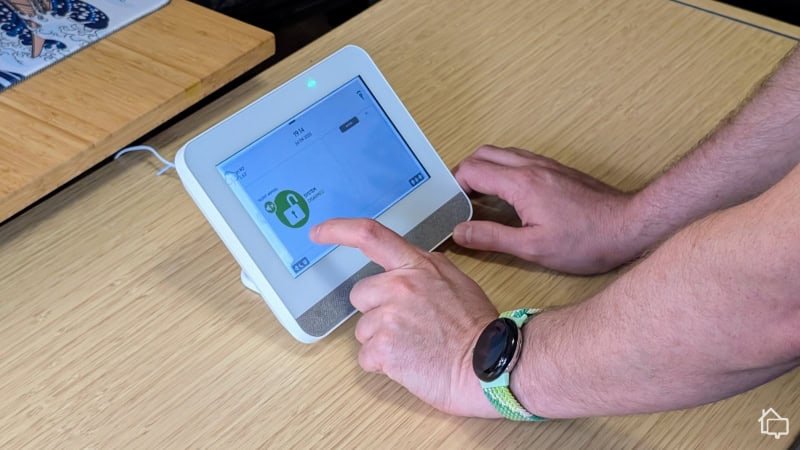
Testing the Frontpoint touch-screen controller after activating our monitoring service.
We prefer month-to-month monitoring plans rather than signing long-term home security contracts. Frontpoint provides both options. The month-to-month plan offers flexibility to cancel whenever needed, while the contract option locks in your rate for the agreement duration. There are also a few exceptions that allow you to cancel your contract.1
If you’re considering a contract, here’s how Frontpoint compares to other major security companies’ optional long-term agreements:
| Contract details | Frontpoint | ADT | Vivint |
|---|---|---|---|
| Initial term | 36 months | 36 months | Up to 60 months |
| Money-back guarantee | 30 days | 180 days | 3 days |
| Early termination fee | 80% of remaining contract value | 75% of remaining contract value | 100% of remaining contract value (except for extenuating circumstances) |
| Monthly charges | $49.99 per month | $34.99 to $49.99 | $19.99 to $49.99 |
| Monthly fee increase | Frontpoint has the right to increase the fee by no more than 9 percent per year | ADT has the right to increase the fee after the first year | Vivint has the right to increase or change the monthly fee at any time |
| Late charge | 1.5% plus a 5% administrative fee | Up to $25 per month plus administrative fees | Depends on location (e.g. $10 in California) |
| Total contract value | $1,799.64 (monthly fee multiplied by initial term length) | At least $1,259.64 (based on $34.99 monthly fee) | At least $1,199.40 (based on $19.99 monthly fee) |
| Automatic renewal | Month to month after the initial term | Month to month after the initial term | Month to month after the initial term |
| Limited warranty | 3 years starting at activation | 1 year starting at the date of purchase | 120 days starting at activation |
Frontpoint’s 30-day money-back guarantee matches the industry standard. It’s shorter than ADT’s generous 180-day period and SimpliSafe’s 60-day window, though. This trial period allows you to test the system and cancel without penalties. After the trial ends, cancelling early means paying 80 percent of your remaining contract balance.
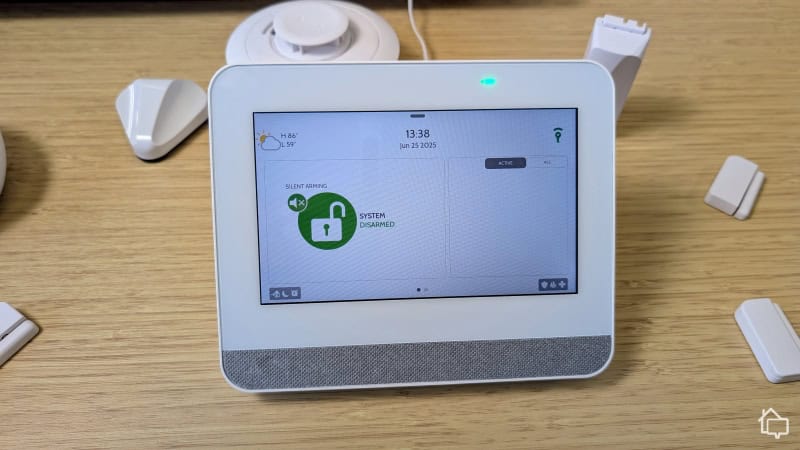
Our Frontpoint touch-screen keypad next to some of the sensors it monitors and controls.
Frontpoint’s Ultimate Monitoring Plan, which is the only option available online, is $49.99 per month. It includes every monitoring feature Frontpoint provides:
Pro Tip: Frontpoint made our list of the most affordable home security systems thanks to its frequent deals. Don’t forget to check out Frontpoint’s current promotions. The company occasionally offers discounted monitoring and equipment packages.
Frontpoint’s base price is competitive with Vivint and not much more than ADT, especially when you realize that Frontpoint comes with smart home and security camera controls, which add up quickly with Vivint.
SimpliSafe, Cove and Ring Alarm offer lower monthly costs, even with their premium plans that include smart-home and camera features. For instance, Ring offers comparable coverage for $9.99 per month. You can add professional monitoring for an extra $10 monthly, taking the total to just $19.99 per month.
While Frontpoint’s Ultimate Professional Monitoring plan covers most features, you can enhance your system with these three optional add-ons:
Expert Advice: Frontpoint made our list of the most affordable home security systems thanks to its frequent deals. Don’t forget to check out Frontpoint’s current promotions. The company occasionally offers discounted monitoring and equipment packages.
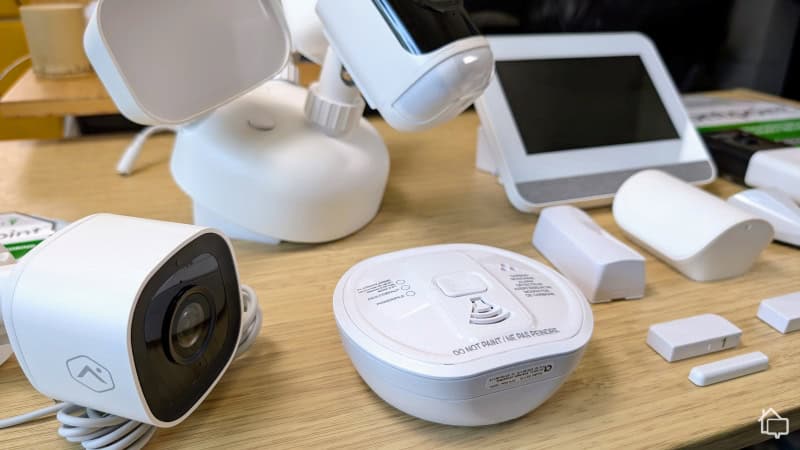
We bought a variety of Frontpoint equipment, including security cameras, security sensors and safety sensors.
For our testing, we purchased a custom package containing 18 pieces of equipment and accessories. The retail price was almost $2,000, but promotional discounts brought our final cost down to around $1,200. Here’s what we got:
FYI: While Frontpoint creates urgency around their promotions, they consistently offer similar discounts year-round. Rather than waiting for a potentially better deal, we recommend securing your home sooner with their current offers.
We tested most of Frontpoint’s sensor and camera lineup. The items we didn’t try included the smart lock, wired doorbell camera, glass-break sensor, indoor smart plug, outdoor smart plug and keychain remote.
We also noticed that Frontpoint doesn’t offer smart thermostats, which are available from both Vivint and ADT. However, Frontpoint offers advanced smart home integrations, so it’ll still work with most smart thermostats. You just can’t buy it directly from Frontpoint. That’s why Frontpoint still made our list of the best smart-home security systems.
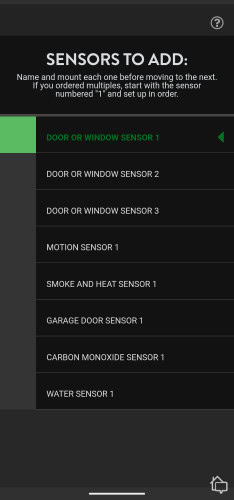
Our entire setup process hinged heavily on the Frontpoint app.
We began by installing the Frontpoint app and entering our activation code. The process took less than five minutes.
Next came the control panel configuration. We tested the Display Hub+ (touch screen), which includes the same Wi-Fi, cellular backup, and battery features as the standard Frontpoint Hub. While the panel handles most settings well, we preferred using the Frontpoint app and web portal.
We did like that the Display Hub+ includes a desktop stand so we could place it on tables or shelves. A wall mounting kit is available separately if you prefer a permanent spot.
FYI: We received our system several days before testing, and Frontpoint sent helpful reminder texts encouraging us to set it up. Remember that the three-year limited warranty starts after you activate the system or 30 days post-purchase, whichever comes first.
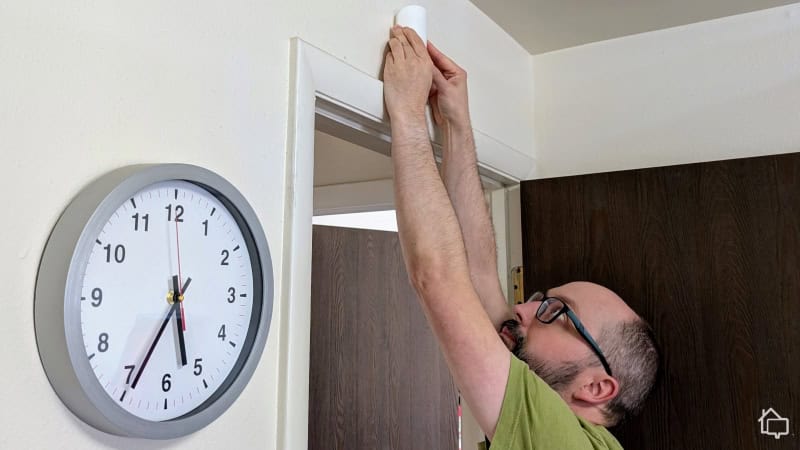
Installing the Frontpoint control panel and sensors took less than 20 minutes.
Frontpoint preprograms every security sensor before shipping your order, which makes it easy to set up and install most of the security system. The only things you need to do are choose where to place your sensors and verify they’re working before installing them.
We installed all sensors using the included adhesive strips, averaging less than a minute per sensor. A ladder was our only tool. We needed it for mounting the motion sensor, glass-break sensor, smoke detector, carbon monoxide detector, and door/window sensors in elevated positions.
Did You Know? We conducted multiple break-in simulations to evaluate sensor performance. In every test, we immediately received app notifications, and Frontpoint’s monitoring center contacted us within seconds.
The motion, smoke, and carbon monoxide sensors include mounting screws and wall anchors for permanent installation. We suggest using them for long-term installations (three-plus years). Keep in mind that drilling anchor holes takes extra time and tools.
You can set up home automation to trigger lights and cameras based on sensor activity, though Frontpoint doesn’t let you adjust individual sensor sensitivity. You can, however, customize chimes and voice alerts for each sensor to help identify which door opened.
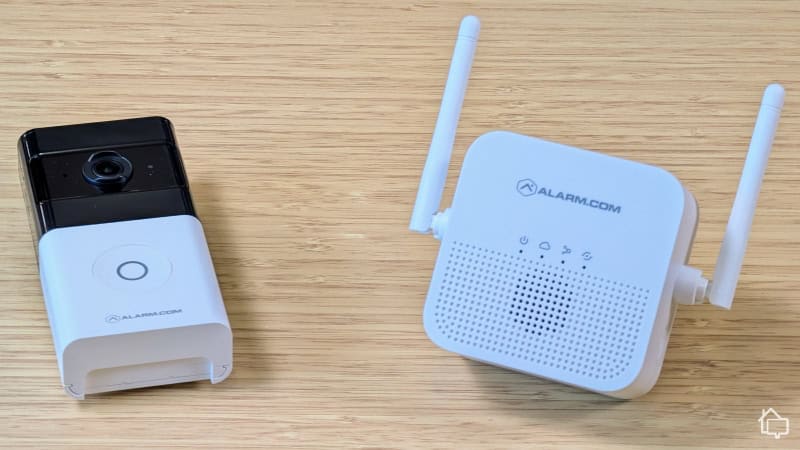
Setting up the Smart Chime was the hardest part of our Frontpoint installation.
As long as we’re talking about installation, we should mention the issues we had with the Smart Chime. The Smart Chime is primarily a wireless chime for the wireless doorbell camera, but it also doubles as a Wi-Fi access point to extend the range of your Frontpoint cameras. Basically, you connect it to Wi-Fi, and then connect your cameras to it. That’s why Frontpoint recommends setting up the Smart Chime before the security cameras.
The included instructions were confusing. Despite connecting our phone to the Smart Chime’s network, the Frontpoint app couldn’t detect it. We checked Frontpoint’s online support resources and found their Smart Chime Master Guide, which didn’t match our physical manual.
The online guide was missing a critical step: “Enter 192.168.173.1 in your mobile browser’s URL bar to access the Wi-Fi setup page.” After following this instruction, our app immediately recognized the device and the setup went smoothly.
>> Related: The Best Home Security Systems With Doorbell Cameras
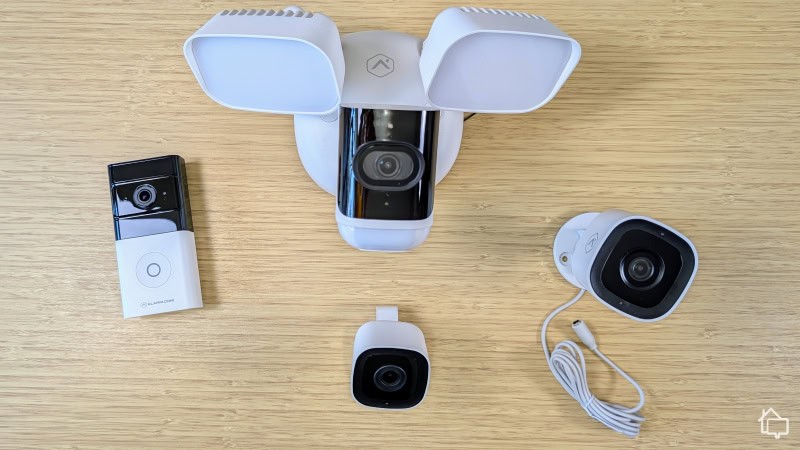
The four Frontpoint security cameras we tested: premium floodlight camera (top middle), outdoor camera (right), indoor camera (bottom middle) and wireless doorbell camera (left).
Setting up cameras was less challenging than the Smart Chime, although each camera required a factory reset. The wireless doorbell camera’s 45-second reset process was particularly lengthy.
We recommend skipping the app’s bulk camera setup option, as it failed for us. We suggest configuring cameras individually.
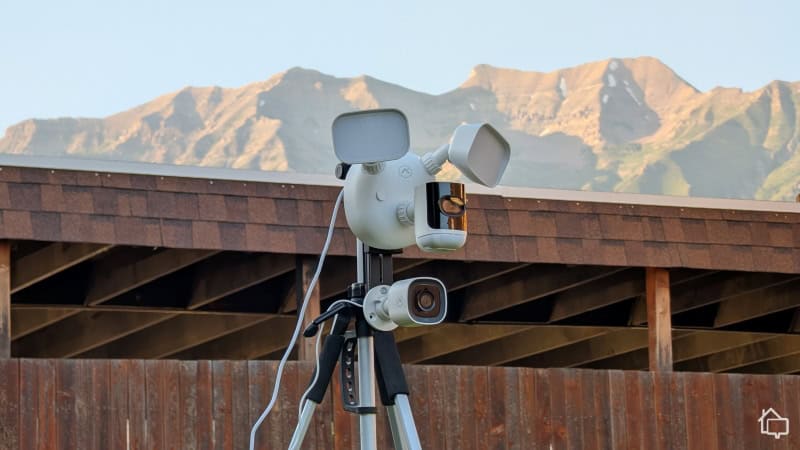
Although we didn’t install the cameras in permanent locations for our testing, the same instructions applied to our mounting blocks.
We recommend planning for 10 to 20 minutes per camera. The time may vary depending on your mounting and drilling requirements. Wall-mounted installations are straightforward. The wireless doorbell, outdoor camera, and premium floodlight camera need multiple screw holes, though.
The indoor camera has a wall mount, but we prefer the built-in stand, which is perfect for placing the camera on a high shelf. The doorbell camera’s bracket includes an angle wedge for downward adjustment on certain porches.
Our biggest issue was the power cords, which have to reach an outlet. We had to run cables through exterior walls, which required larger drill bits. Running the cables along walls is another option.
Expert Insight: From its bulky body and hardwired installation to the two protruding floodlights, the premium floodlight camera from Frontpoint is similar to ADT’s Nest Cam with floodlight. Check out our experience with that other camera in our ADT security system hands-on review.
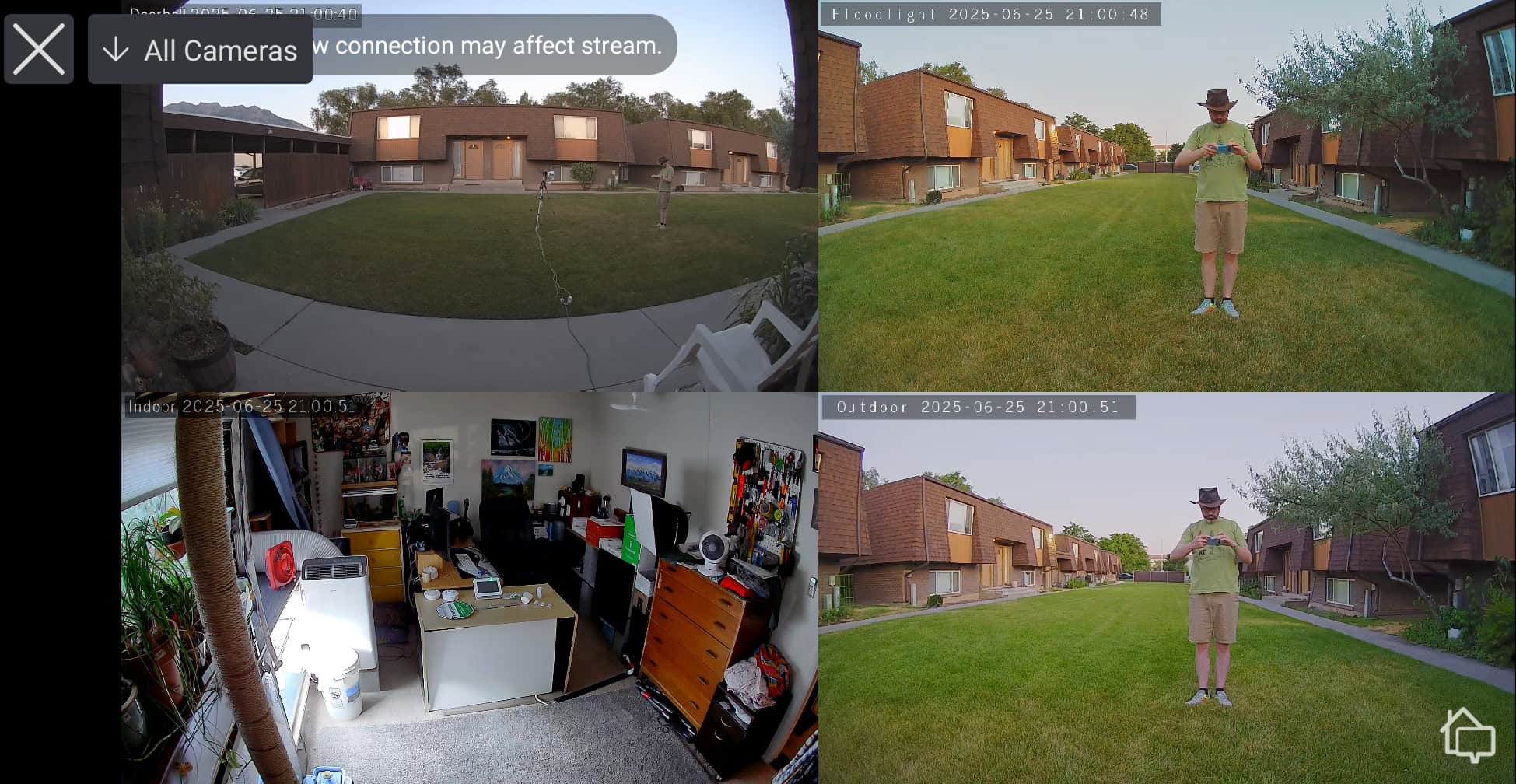
You can tie camera recordings to alarm modes so they record only when you arm the Frontpoint system or when an alert triggers.
Thankfully, using a Frontpoint camera is much easier than setting it up. Let’s run through a few features they share before highlighting their strengths and weaknesses. Here’s what every Frontpoint camera has in common:
Now that we covered the features you can expect from every Frontpoint camera, let’s dig into more specifics about each camera and your options for recording footage.
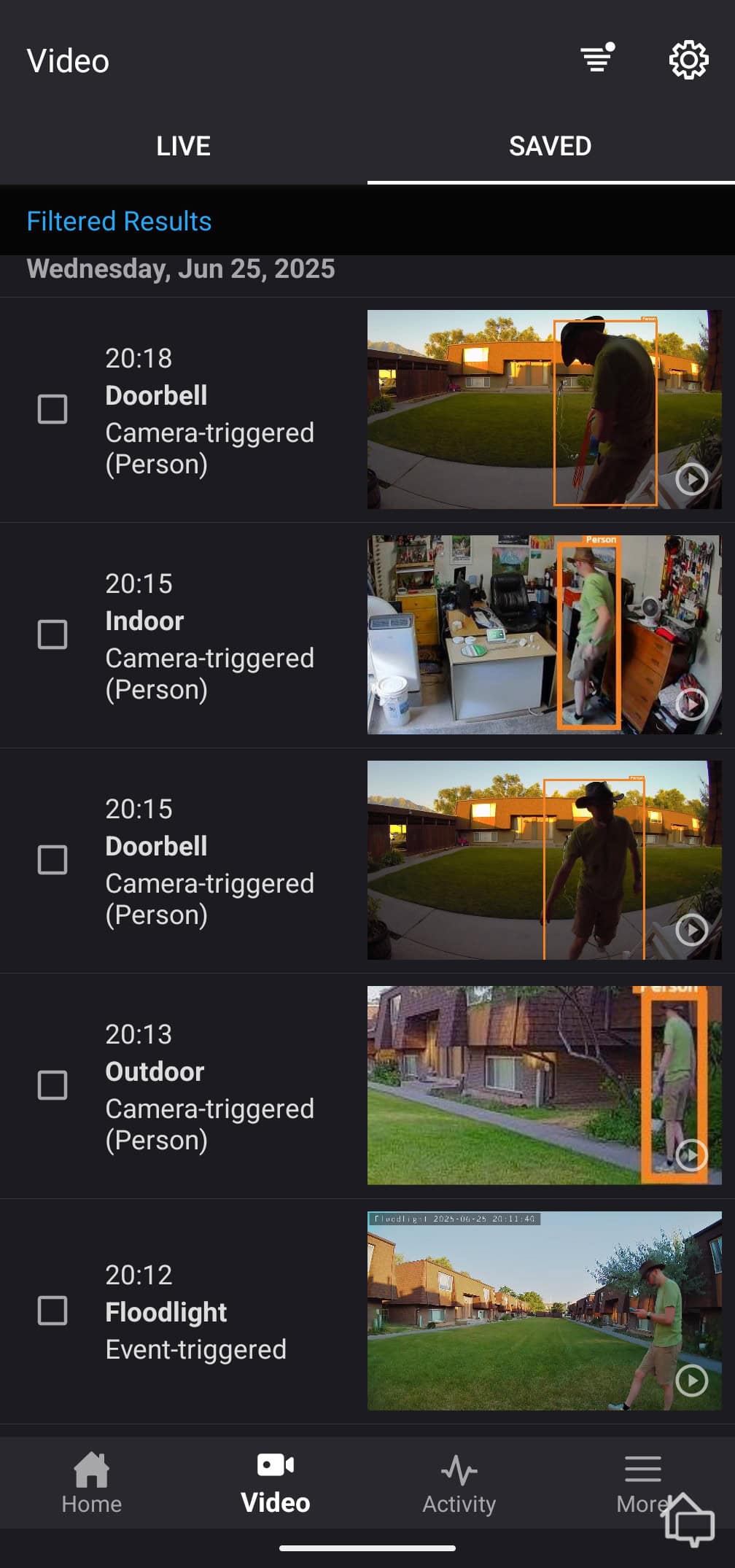
Frontpoint’s flexible video storage options are a nice perk.
For video storage, Frontpoint lets you store up to 3,000 clips per month with the Ultimate Monitoring plan. That number is shared by all your cameras, which wasn’t a problem with our four-camera setup. If you need more, though, you can buy additional cloud capacity as an add-on.
One unique thing about Frontpoint is that the indoor camera, outdoor camera and premium floodlight camera all support local storage on a microSD card in addition to cloud storage. That means you can save continuous video footage to fill in the gaps between motion-activated cloud recordings.
Most cameras for home security systems don’t include onboard storage, let alone support for microSD cards. Eufy (used by Cove), Google Nest (used by ADT), SimpliSafe and Ring, for example, use only cloud storage. Some Vivint cameras also work with microSD cards.
>> Read More: Our Review of Vivint Security Cameras
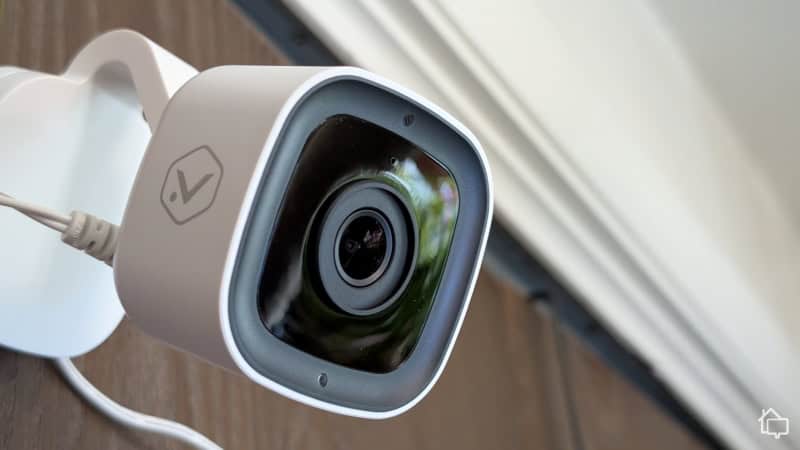
The indoor camera is very easy to use.
The indoor camera’s biggest strength is its easy setup and placement. The cord was even long enough to reach high shelves far from the power outlet. Other than that, it’s a bog-standard home security camera.
>> Other Options: The Best Indoor Security Cameras of 2025
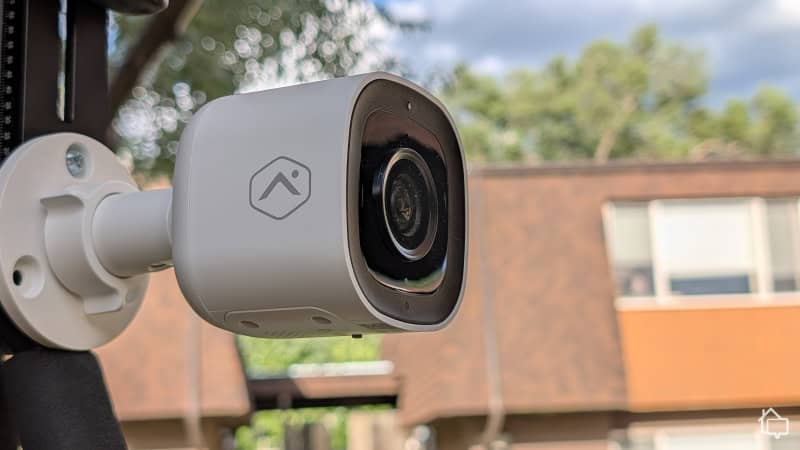
The outdoor camera showed a clear view of the courtyard outside our home.
We like the outdoor camera’s relatively compact design, metal case and weatherproofing. Its cord isn’t much longer than that of the indoor model, though, so you’ll need a nearby sheltered outlet outdoors if you don’t want to run the cable indoors.
Along with the premium floodlight camera, it can use Frontpoint’s new AI Deterrence voice messages. That costs extra, however, and it includes only 10 automated deterrence actions each month.
>> Other Options: The Best Outdoor Security Cameras of 2025
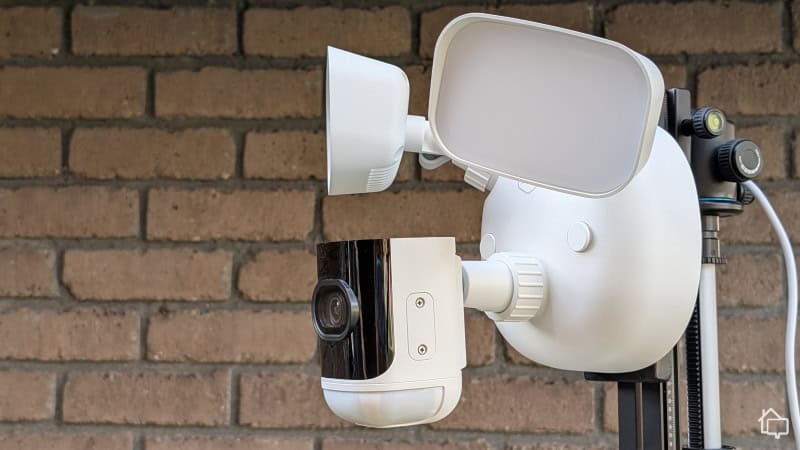
You can reposition the bright floodlights and camera to target specific areas in your yard.
Frontpoint’s premium floodlight camera is large and visually intimidating, especially if you create an automatic recording rule to illuminate unwelcome nighttime visitors. You can control the lights independently of the camera, making it easy to integrate into your smart-home automations. We like having the light turn on when opening a door for extra visibility at night.
>> Compare: Ring Floodlight Cam Review in 2025
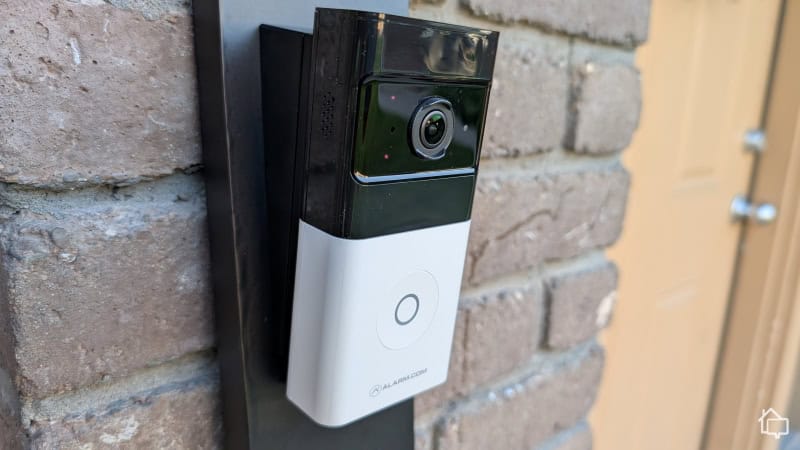
Because there’s no wiring to mess with, you can install it anywhere, like on a gate at the edge of your property.
The wireless doorbell camera requires occasional recharging, but it’s generally a better option for most people than the wired model. It requires the Smart Chime to work. It was a hassle to set up, but the Chime’s customizable tones and ability to boost Wi-Fi range are nice upgrades over an existing mechanical chime.
>> Other Options: The Best Video Doorbell Cameras of 2025
Frontpoint’s hardware generally worked as expected, but that’s only half the equation. We were also interested in finding out how well Frontpoint responds to alarms, especially because the system requires professional monitoring to work. Not to spoil anything, but Frontpoint made our list of this year’s best monitored home security systems.
One thing we liked about Frontpoint is its use of dual-path communication — the main hub essentially communicates via Wi-Fi and cellular signals, whichever is available. If the Wi-Fi is down, it uses cellular signals to send alerts to the monitoring center; if there’s no cellular signal available, it uses Wi-Fi to generate alerts. It’s thanks to this dual-path technology that Frontpoint made our list of the best cellular security systems.
Frontpoint has a 30-second entry delay by default. That means you have 30 seconds to disarm the system after triggering a sensor, such as when a door sensor is triggered after you enter the front door. That gives you time to cancel outgoing false alarms. You can increase the entry delay time to up to three minutes, but, in our opinion, 30 seconds is more than enough. Keep in mind that during those 30 seconds, Frontpoint won’t be notified.
If you don’t disarm the system during the entry delay period, the triggered sensor sends an active alarm. That’s when Frontpoint’s monitoring center is notified, triggering an alarm response that goes like this:
In our experience, the entire process takes an average of 20 to 30 seconds after the initial entry delay period. That is pretty good, and still within the 60-second industry average. Of course, you can speed up the process by responding immediately to the text or app alert. Doing so will bypass the phone alert and immediately have Frontpoint dispatch help to your address.
FYI: During our break-in simulations, text alerts from Frontpoint arrived about 10 seconds before phone alerts. Text alerts also include a link to a browser-based messaging app through which you can cancel or confirm the alarm. That’s similar to what we’ve seen from SMART Monitoring from ADT, one of the best security systems with fast response times.
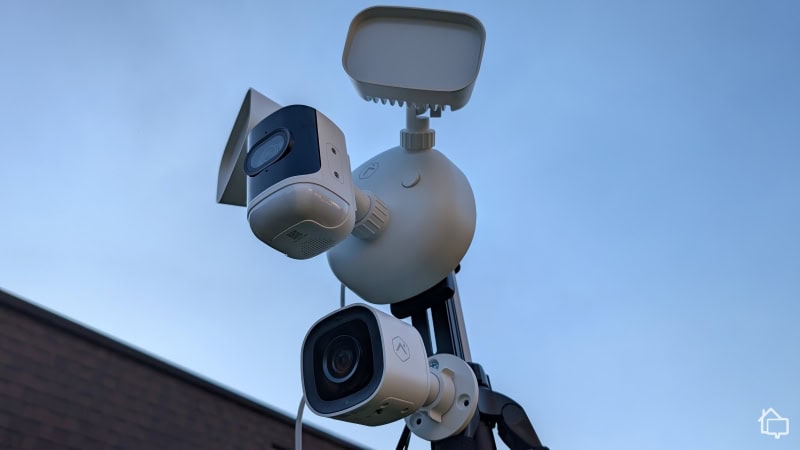
Frontpoint’s monitoring center uses security cameras to verify and score alarms in order to speed up police response.
We also discovered that Frontpoint uses video verification to potentially speed up alarm response. They follow the Alarm Validation Scoring Standard (AVS-01) from the Monitoring Association. That standard sets an alarm level score for each alarm event. The highest levels — 3 and 4 — mean there’s a confirmed threat to property (e.g. burglary in progress) and confirmed threat to life (e.g. home invasion), respectively.2
Following a standard like the AVS-01 makes the flow of information between monitoring centers and law enforcement smoother during real emergencies. Several well-respected names in home security are already using AVS-01, including ADT, SimpliSafe and RapidResponse (Frontpoint’s monitoring partner).
>> Compare: ADT vs. SimpliSafe
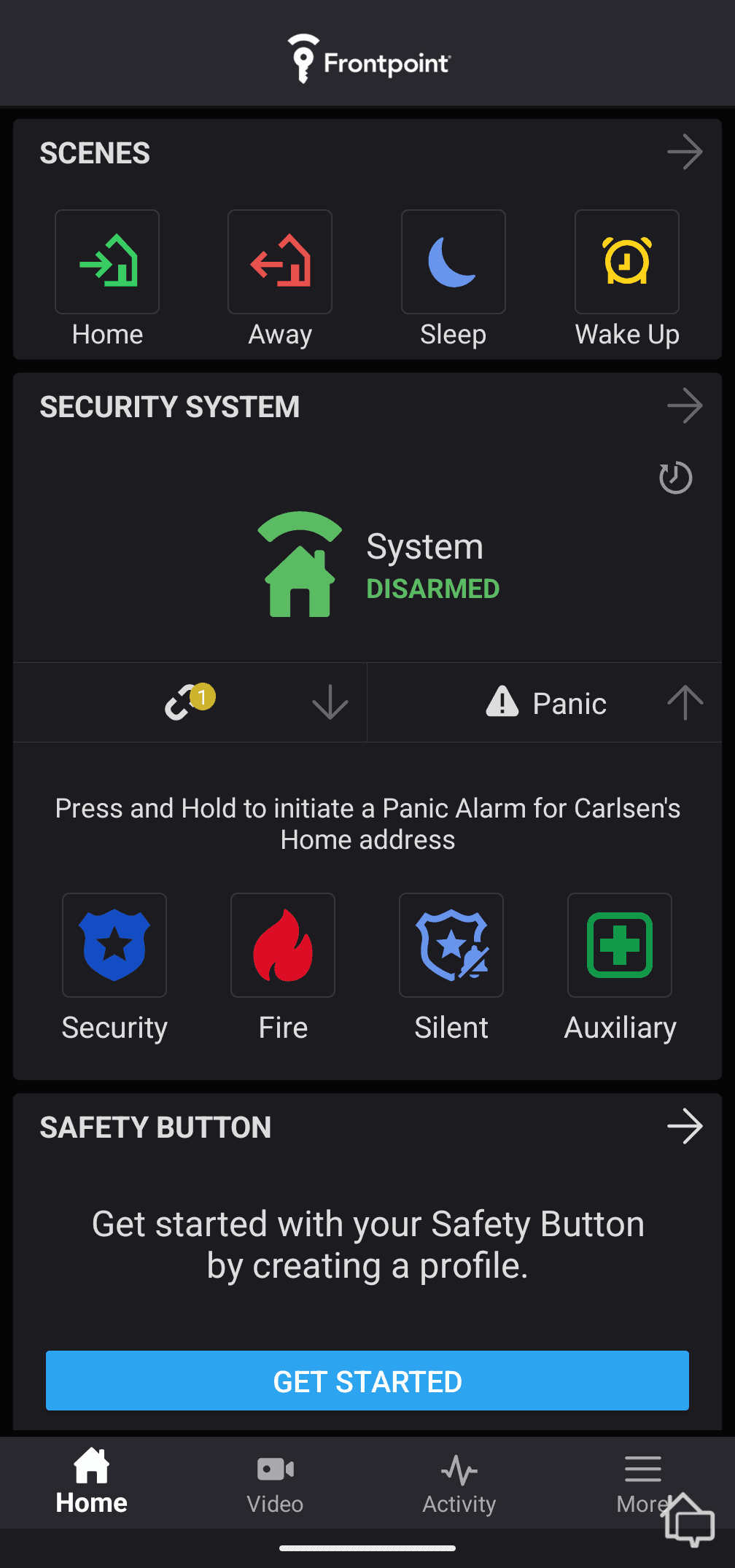
Aside from the few issues we had setting up our cameras, the Frontpoint app is easy to use with a layout that makes sense.
Like Frontpoint security systems, the app home screen is customizable. As you can see above, our arm/disarm option is front and center for easy access. We also preprogrammed phone numbers for the fire department and ambulance, just in case.
The Scenes section gives us easy access to home automation features. Pressing the home button disarms the security system, unlocks the smart lock on the front door and double-checks our garage door is closed. The sleep sequence switches off our smart lights, locks all doors and confirms the windows closed via entry sensors.
FYI: You can use the Frontpoint Alexa Skill to control your system with Echo smart speakers and displays. This gives you control over arming, smart devices and scenes. The system also works with Apple Home and Siri, but it isn’t compatible with Google Home.
Frontpoint also lets you add third-party smart-home devices to automations, including those using the Z-Wave smart home protocol, but only those listed in its Third-Party Compatible Products Guide. The smart home automations cover the basics, with time-, event- and location-based triggers in addition to the manual controls. The automation rules work well with Alexa and Siri.
The Frontpoint app can do more than automations. You can check your video feed, review events and adjust settings for every device connected to your system. We also set up a geofence. When we leave the house in a rush, we forget to arm the system. Now Frontpoint alerts us when we’re outside the geofence. Instead of turning back, we arm it in the app.
We tested all of Frontpoint’s contact methods. We emailed them, filled out an online form and used web chat. It took a little longer than we would have liked for an email response, but the web chat responses were fast and friendly.
Calling Frontpoint is the best way to get questions answered. We spoke to two different consultants on separate occasions when we had an issue with connecting our camera to the Wi-Fi. The support from both Frontpoint representatives was excellent and they managed to solve our problem quickly and efficiently.
The Frontpoint security system is a solid low- to midpriced option for most homeowners and worth considering for folks who aren’t interested in Vivint or ADT home security. This is especially true when you buy Frontpoint gear during one of the brand’s regular sales. The three-year contract for this DIY home security system can’t beat the month-to-month options from SimpliSafe though.
On the equipment front, Frontpoint’s compatibility with a relatively large number of smart-home devices gives it an edge over SimpliSafe’s weaker smart-home offerings and holds strong against most other competitors. Even though the setup process for Frontpoint security cameras didn’t go as smoothly as we hoped, the cameras are straightforward to learn for most people.
If you’re a renter, your best bet is to go with a month-to-month contract option, which may be harder to get with Frontpoint than with rival brands such as SimpliSafe and Cove. The three-year contract option, however, is probably better for homeowners who are comfortable committing long term.
Our team of security experts leverages years of experience to provide our readers with reviews that accurately represent how security systems perform in real-world settings. Essentially, we test security systems in our own homes. We follow each security provider’s ordering and setup process like a typical homeowner.
After installation, we spend a week or two learning each system’s features, quirks and drawbacks. In addition to using a system during our everyday schedule, we simulate alarms, test sensors and evaluate security cameras to see how these line up with our experiences on other security systems.
If your Wi-Fi drops out, Frontpoint connects to Verizon’s cellular network. The hub only uses cellular to communicate with the Frontpoint monitoring center for faster responses.
Frontpoint offers month-to-month and three-year contracts. The three-year contract applies only if you’re financing your equipment.
No, you’ll need to subscribe to a professional monitoring plan for your Frontpoint system to work.
Yes, it does. You can integrate all current Google Nest Thermostat models and any thermostats that use Z-Wave connectivity. The best part is you can add the third-party devices into your home-automation routines.
SimpliSafe offers more affordable equipment and monitoring plans, including a free self-monitoring option. If you’re looking for smart-home automation features, Frontpoint is the better choice.
Federal Trade Commission Consumer Advice. (2023). Solving Problems With a Business: Returns, Refunds, and Other Resolutions.
https://consumer.ftc.gov/articles/solving-problems-business-returns-refunds-and-other-resolutions
The Monitoring Association. (2024). ANSI/TMA-AVS-01 2024 Alarm Validation Scoring Standard.
https://tma.us/standards/tma-avs-01-alarm-validation-standard/#Alarm